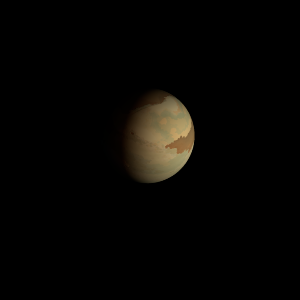|
|
Space Astro
|
Info for exoplanet "Oshweng-dang"
| Scientific (actual) data |
|---|
| Name | Kepler-1714 b |
| Planet status | Confirmed |
| Radius | 0.2912 |
| Orbital period | 10.2753 |
| Semi major axis | 0.1047 |
| Orbit eccentricity | 0 |
| Inclination | 88.49 |
| Discovered | 2011 |
| Updated | 2024-06-09 |
| Tzero tr | 2455010 |
| Impact parameter | 0.315 |
| Temperature (kelvin) | 1211 |
| Publication | Published in a refereed paper |
| Detection type | Primary Transit |
| Radius measurement type | Primary Transit |
| Alternate names | KOI-288 b, KOI-288.01 |
| Star name | Kepler-1714 |
| Right ascension | 293.72° |
| Declination | 46.23° |
| Mag v | 11.02 |
| Mag j | 10.01 |
| Mag h | 9.774 |
| Mag k | 9.705 |
| Star distance | 409.46 |
| Star metallicity | 0.116 |
| Star mass | 1.14 |
| Star radius | 2.156 |
| Star sp type | F9/G0IV |
| Star age | 3.05 |
| Star temperature | 6088.22 |
| Star alternate names | KIC 9592705, 2MASS J19345194+4613358, KOI-288 |
| Wikipedia article | Kepler-1714 b |
Back
| |
| Fictional info (?) |
|---|
| Suggested name | Oshweng-dang |
| Planet type | Warm planet |
|
The surface of this brutal planet is full of barbaric earth-like bacteria that survive only by consuming the somewhat smaller "Ozeiw". The Wwobwoh are related to the Qyaoq An but with 4 arms and vary in length from 7 to 10 cm. Wwobwoh are known to reproduce at temperatures from -40 to -20°C and also the high radiation level. |
| Estimated population | 40000000 |
| Atmosphere | Water | 88% |
| Methane | 11% |
| Carbon dioxide | 0.12% |
| Oxygen | 0.055% |
| Atmospheric pressure | 0.011 bar |
 |
| No known satellites |
| Google search for Oshweng-dang |
|
Website by Joachim Michaelis
|
|
|
|